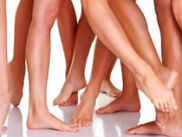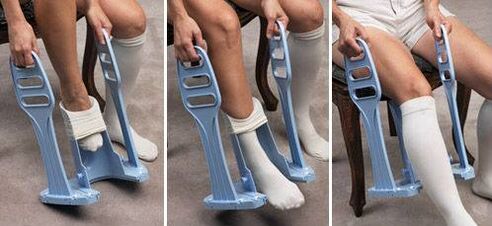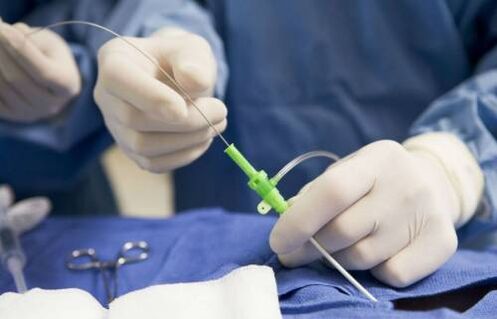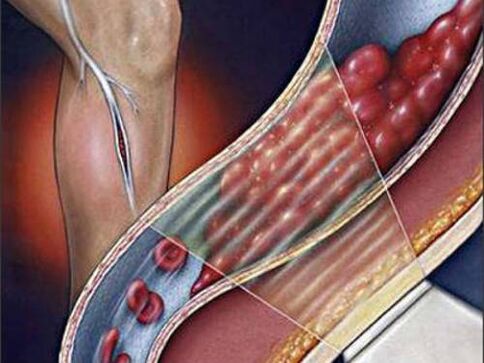
Varicose veins are a common disease characterized by enlargement of the vascular lumen, disruption of the valve apparatus, and regurgitation of blood flow.The pathological process can be localized in different parts, so the disease has the following types:
- esophageal vein dilation;
- Rectal veins (hemorrhoids);
- pelvic veins;
- spermatic vein (varicocele);
- Veins of the lower limbs.
The most common are varicose veins in the legs.It is estimated to affect more than 30% of the population, the majority of whom are women.Varicose veins in the legs are not only unsightly protruding veins, they can also cause a lot of unpleasant sensations and inconveniences.Its pathological process is accompanied by heaviness, pain, swelling and often leads to dangerous complications: thrombophlebitis, thrombosis, trophic ulcers.Many people wonder how to get rid of varicose veins for good, as they can seriously impair quality of life.But unfortunately, this phenomenon is irreversible and the only thing that can be achieved is to stop or slow down the progression of the disease.
reason
The cause of varicose veins is not completely understood.It is clear that this disease is associated with thinning, weakness and loss of elasticity of blood vessel walls, as well as valve insufficiency.As a result, veins become unevenly dilated, stretched, elongated, tortuous, and knotty.It is believed that a genetic predisposition, with fragile blood vessels and defective valves present from birth, plays a decisive role in the development of the disease.
There are many factors that contribute to the development of varicose veins, although they are not their cause:
- Heredity (according to experts, people whose parents have the disease have up to a 70% risk of developing it).
- Belongs to the female gender.This is caused by hormonal changes during puberty, pregnancy and menopause, as well as taking hormonal birth control pills and wearing high heels.
- Work activities involving prolonged standing or sitting (barbers, salespeople, surgeons, waiters, drivers, accountants, programmers, etc.).
- Weakening of blood vessel walls and wear and tear of the valve apparatus is a natural phenomenon in old age.
- Surgical intervention.
- Sedentary lifestyle.
- Increased intra-abdominal pressure due to excess weight, pregnancy, heavy lifting (loaders, weight lifters), regular exertion with chronic constipation and coughing.
Treatment
Varicose veins are a chronic process that begins gradually and only progresses over time.Today, it is impossible to completely defeat the disease, but it is possible to slow its progression and reduce symptoms if complex treatments are used, which include:
- lifestyle changes;
- diet;
- physical therapy;
- Compression therapy;
- Medications (internal and topical use);
- surgical intervention;
- thermal program;
- traditional method.
You will have to fight varicose veins throughout your life.You should not self-medicate.You will need to be examined by a phlebologist or vascular surgeon, who will make a diagnosis, determine the stage of the disease and the severity of the lesions, and prescribe appropriate treatment.The main task is to eliminate or reduce clinical manifestations, prevent disease progression, and prevent recurrence and complications.
The effectiveness of treatment will depend on the patient's compliance with all of the doctor's recommendations.It is important to seek help as early as possible, when there is no pain but swelling, heaviness and fatigue in the legs at night, as well as the appearance of small spider veins on the skin.
lifestyle modification
It is impossible to effectively combat varicose veins without lifestyle changes.The rules to follow are decidedly mediocre, and failure to follow them is often associated with a lack of willpower or an irresponsible attitude toward health.
- Maintain a normal weight.
- Get rid of bad habits: alcohol and smoking.
- Sunbathing, steam rooms, saunas, and hot baths (including foot baths) are prohibited.
- Refuse to wear high heels (no more than 4-5 cm in height).
- Wear special elastic knitwear.
- Provide physical activity.This could be walking, swimming, physical therapy or some exercise.Mainly exclude squats, weightlifting, long-distance running, jumping, martial arts, etc.
- Proper nutrition.The diet should include more fresh vegetables, fruits, herbs, whole grains and seafood.It is recommended to reduce the amount of meat.You need to cut out smoked, fried, salty, and greasy foods.In terms of beverages, green tea, purified water, fruit juice drinks, natural fresh juices are preferred, and coffee is limited.
- Take every opportunity during the day to raise your legs to an angle of approximately 20 degrees.
- Buy a special pillow for your feet so that they are higher than your heart when you sleep.
- Try to rinse your feet with cold water as often as possible.
Compression therapy
Today, there are many varieties of specialty stretch knitwear.These are knee-high socks, stockings, and tights of varying colors and densities that are really no different from regular ones.They have become a good alternative to elastic bandages that are inconvenient and visually unsightly.
Special knitwear cannot treat varicose veins, but it can improve microcirculation and reduce venous pressure. Prevent blood stagnation, narrow the diameter of blood vessels, and increase the outflow of venous blood and lymph fluid.The person's legs feel lighter, less tired at night, and less swollen.
Prevent blood stagnation, narrow the diameter of blood vessels, and increase the outflow of venous blood and lymph fluid.The person's legs feel lighter, less tired at night, and less swollen.
At first, it can be difficult if you are not used to putting on compression stockings with your hands.To make your task easier, you can buy special equipment.
Therapeutic knitwear can be divided into four categories based on the pressure applied.You can only wear Level 1 compression products on their own, as these are considered preventive and more suitable for healthy people.The rest should be prescribed by a doctor based on the diagnosis and severity of varicose veins.You should be aware that pressure products may be contraindicated in certain medical conditions.Doctors must choose tights or stockings strictly according to size, otherwise the ideal effect will not be achieved.
drug treatment
For the treatment of varicose veins, topical agents in the form of tablets and gels, creams and ointments of various ranges of action are used.They increase blood vessel tone, improve microcirculation, promote blood outflow, and prevent skin changes.The medicine is designed to eliminate fatigue, heaviness, discomfort, swelling, itching, cramps and leg pain.Their appointment is entirely personal.

The mainstay of treatment for varicose veins is intravenous injection.They are based on horse chestnut, rutin, grape leaf and are almost always well tolerated by patients.Available in tablet, capsule, and gel forms.
To reduce blood viscosity and reduce the likelihood of developing thrombophlebitis, anticoagulants are used.These ointments contain cooling additives such as menthol, camphor, and eucalyptus.In addition to thinning the blood, they may prevent the development of thrombophlebitis.
Antihistamines may be prescribed for skin changes that cause itching.For inflammation, nonsteroidal anti-inflammatory drugs may be taken.
surgical intervention
To eliminate varicose veins, surgery is required to remove the affected portion of the blood vessel to stop the flow of blood from the superficial veins to the deep veins.This surgery is called a phlebectomy.Its classic form is used less and less today due to the emergence of new, less invasive methods of treating varicose veins.This treatment is usually reserved for large vein diameters and cases of advanced disease.
A gentler method is venectomy, in which part of the vein is removed, not through an incision but through a puncture.
Thermal method

Radiofrequency ablation is considered the safest and least invasive method of treating varicose veins, although it has some contraindications.This method involves the thermal effect of microwaves, which closes the venous lumen.Main advantages:
- outpatient treatment;
- No anesthesia or incision is required;
- Recovery doesn’t take much time;
- The procedure is easily tolerated;
- This can be done in the summer;
- There was no bruising and minimal swelling and pain after the treatment.
Laser coagulation is another method of treating varicose veins.During this procedure, laser light is applied to the blood vessel walls.The radiation causes the vein walls to bond and completely close the lumen.The surgery is performed on an outpatient basis under local anesthesia and requires no incisions.A catheter is inserted into the venous lumen, an LED is inserted through the catheter and radiation is applied.The procedure is minimally invasive and complications are rare.
Sclerotherapy

This non-surgical method is one of the most common.It is used in small veins and as part of surgery and complex treatments.The bottom line is that a special drug with a hardening effect is injected into the vein using a fine needle.As a result, the blood vessel walls stick together, closing and preventing blood flow.The affected veins become fibrous cords.The main advantages of this method:
- outpatient treatment;
- Low incidence;
- easy to implement;
- The operation time is about 20 minutes;
- Good cosmetic effect.
traditional method
walnut tincture
Place the chopped unripe walnuts in a glass bowl and pour over the olive oil.Place in sunlight for 40 days.Apply as needed, lubricating affected area.Treatment should last approximately four months.
cabbage leaves
Cut off a cabbage leaf, apply a layer of olive oil on one side, apply this side to the affected area, bandage it and leave it for a day.Continue treatment for one month.

Buckeye
This is one of the most effective folk remedies.To treat varicose veins, prepare a tincture from the fruits of the plant, crush it, half-fill it in a glass container (three liters) and pour vodka.Leave in a dark place for a month, stirring occasionally.When ready, rub the sore area overnight.Chestnut alcohol tincture for topical and internal treatment of varicose veins can be purchased at pharmacies.
practise
When varicose veins appear, the question may arise whether it is possible to participate in sports and which exercises are useful.Most doctors agree that physical activity is very important in this disease, because being active is good for the veins and being static is bad.But it's also important to talk to your doctor about what exercises you can do and what loads are optimal.In addition, patients can be shown special therapeutic exercises, which are performed directly in the medical facility.There are simple but effective exercises you can do at home that will help reduce the symptoms of varicose veins.
- Lie on your back with a pillow under your feet so that it rises at a 20-degree angle.Close your eyes, relax completely, and breathe deeply.
- Lie on your back, lift your legs vertically, and rotate your feet in and out alternately.
- Lie on your back and make a motion with your legs similar to riding a bicycle.
- Lie on your back, lift your legs and cross them (scissors).
- Stand up straight with your arms hanging down and your feet together.Slowly raise your toes and then lower them just as slowly.
- Walk in place, placing your socks on the floor.
- Sit in a chair and bend your legs toward and away from you at the ankles, then bend your fingers in the same way.
- Water your feet with a springy stream of water (alternating cold and warm water).
in conclusion
Varicose veins are an irreversible process, but it is necessary to treat them, especially since there are quite a few modern methods that need to be combined.Without treatment, there is a high risk of complications such as chronic venous insufficiency, phlebitis, thrombophlebitis, thrombosis, trophic ulcers, and even dangerous conditions such as pulmonary embolism that can lead to death.


















